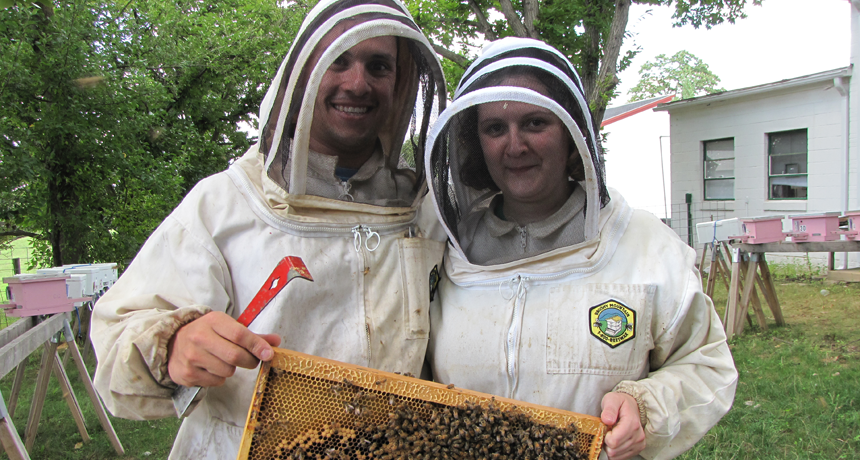Questions for ‘Cool Jobs: Abuzz for bees’

Together, Elina and Bernardo Niño study health and disease in these California honeybees.
Christina Grozinger
Share this:
- Share via email (Opens in new window) Email
- Click to share on Facebook (Opens in new window) Facebook
- Click to share on X (Opens in new window) X
- Click to share on Pinterest (Opens in new window) Pinterest
- Click to share on Reddit (Opens in new window) Reddit
- Share to Google Classroom (Opens in new window) Google Classroom
- Click to print (Opens in new window) Print
To accompany feature ‘Cool Jobs: Abuzz for bees’
SCIENCE
Before Reading:
1. What are some of the reasons that people rely on bees?
2. Why might scientists want to study how bees fly?
During Reading:
1. Name two products bees make that people can use.
2. What “services” do bees provide that help farmers produce the foods that you eat?
3. What is a varroa mite?
4. Name some effects this mite can have on a honeybee hive.
5. Why aren’t traditional pesticides all that helpful for controlling varroa mite infestations?
6. What are biopesticides?
7. Why did Robert Wood look to honeybees for help designing his robots?
8. What are some jobs a swarm of RoboBees might do in the future?
9. What did Tobias Oloffson discover in the honey stomachs of bees?
10. What effect did Oloffson’s honey ointment have on horses?
After Reading:
1. What’s the most recent thing you used or ate that a bee helped produce?
2. How might threats to bees affect people?
MATH
1. Pollinators contribute more than $24 billion in benefits to the U.S. economy, according to the federal government. Honeybees account for more than $15 billion of that. On a percentage basis, what share of the pollination benefits are provided by these bees? Show your work.
2. California’s almond growers depend on the pollination services of some 1.4 million beehives each year. If that’s 60 percent of all U.S. beehives, how many beehives are there in the United States? Show your work.
3. U.S. almonds bring some $4.8 billion dollars into the U.S. economy each year. Based on the information in the previous question, what share of that $4.8 billion would each beehive that services almond growers be responsible for, on average, to the U.S. economy? Show your work.